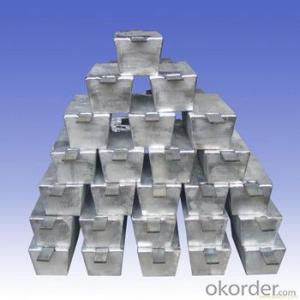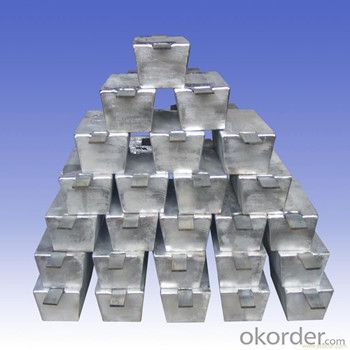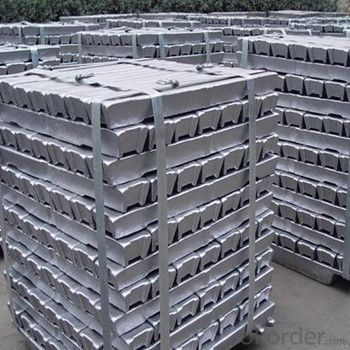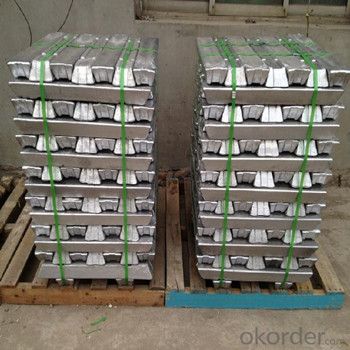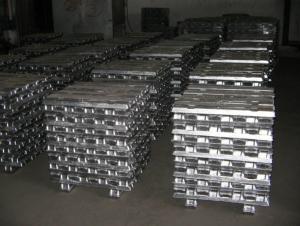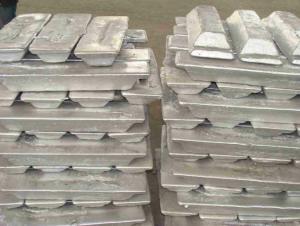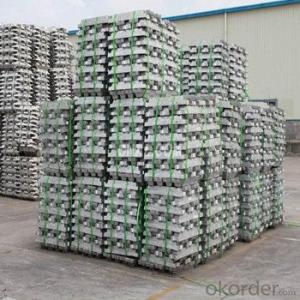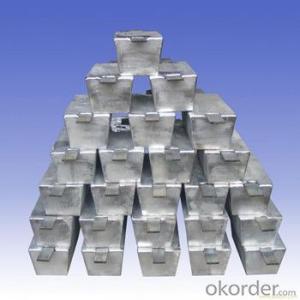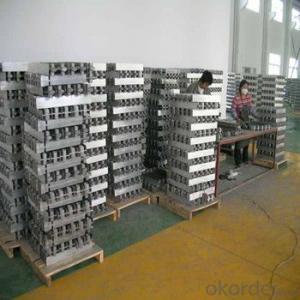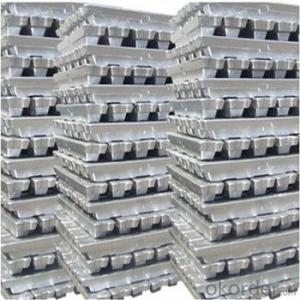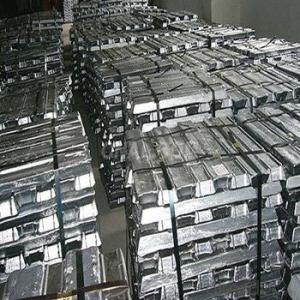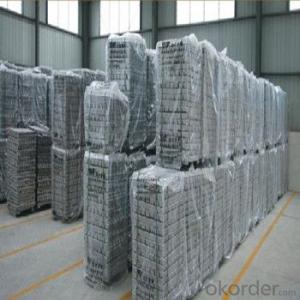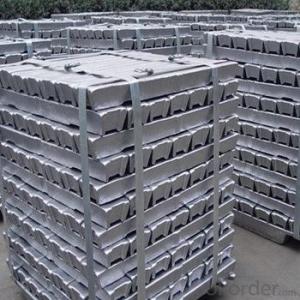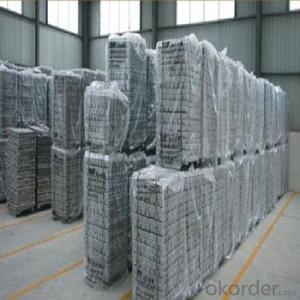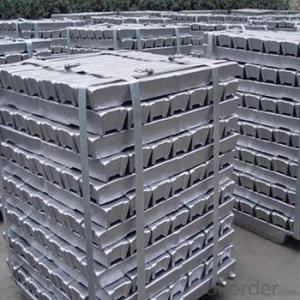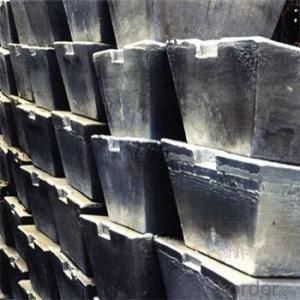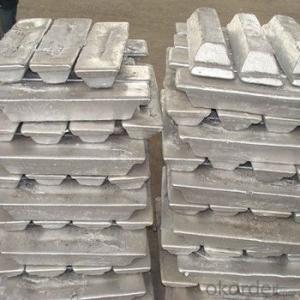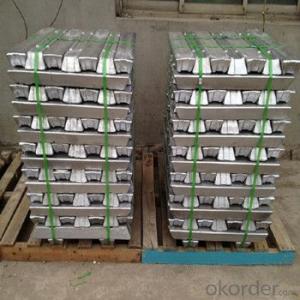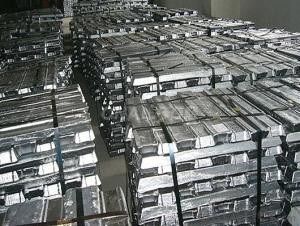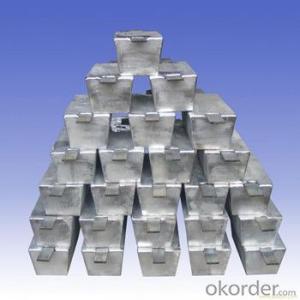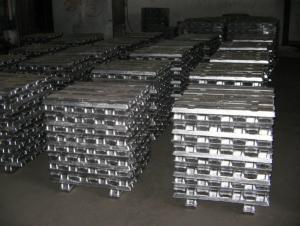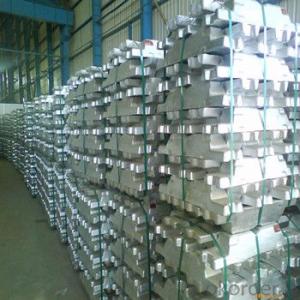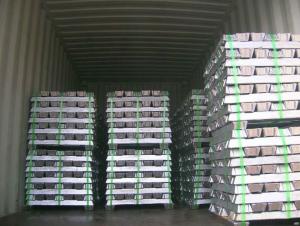Aluminum Pig/Ingot With Different Purity For Choice
- Loading Port:
- China main port
- Payment Terms:
- TT OR LC
- Min Order Qty:
- 1000 m.t.
- Supply Capability:
- 100000 m.t./month
OKorder Service Pledge
OKorder Financial Service
You Might Also Like
Pure Aluminum Pig/Ingot Used for Industry
1.Structure of Aluminum Pig/Ingot
A material that has been cast into a shape in order to be transported and processed easier than in an unprocessed form. An ingot is typically rectangular in shape, which allows it to be stacked. Ingots are most commonly associated with metals, with ingots of gold held in the vaults of banks and brokerages being popular images.
Aluminum Ingot is with the AL as the main chemical composition.Aluminum Ingot is used for industry,such as automobile,pinning and weaving,electron broadly and so on. Aluminum Ingot has the following advantages: easy control and operation, fast melting.
2.Main Features of the Aluminum Pig/Ingot
•High Purity
•Easy control and operation
•High strength
•Fast melting
•Competitive price
•Best Service
3.Aluminum Pig/Ingot Images
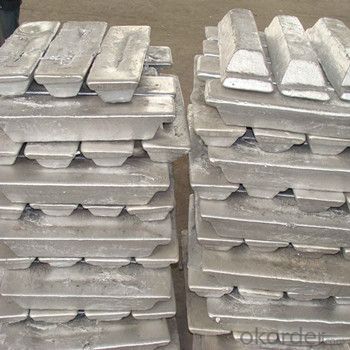
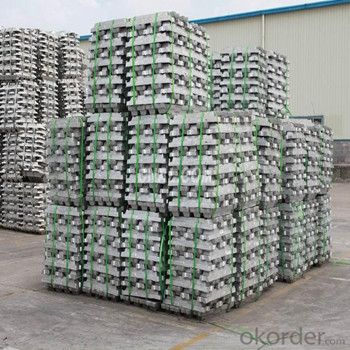
4.Aluminum Pig/Ingot Specification
Grade | Chemical Composition % | |||||||||
Al≥ | impurities ≤ | |||||||||
Si | Fe | Cu | Ga | Mg | Zn | Mn | others | Sum | ||
Al99.9 | 99.90 | 0.50 | 0.07 | 0.005 | 0.02 | 0.01 | 0.025 | - | 0.010 | 0.10 |
Al99.85 | 99.85 | 0.80 | 0.12 | 0.005 | 0.03 | 0.02 | 0.030 | - | 0.015 | 0.15 |
Al99.7 | 99.70 | 0.10 | 0.20 | 0.010 | 0.03 | 0.02 | 0.030 | - | 0.030 | 0.30 |
Al99.6 | 99.60 | 0.16 | 0.25 | 0.010 | 0.03 | 0.03 | 0.030 | - | 0.030 | 0.40 |
Al99.5 | 99.50 | 0.22 | 0.30 | 0.020 | 0.03 | 0.05 | 0.050 | - | 0.030 | 0.50 |
Al99.00 | 99.00 | 0.42 | 0.50 | 0.020 | 0.03 | 0.05 | 0.050 | - | 0.050 | 1.00 |
5.FAQ of Aluminum Pig/Ingot
We have organized several common questions for our clients,may help you sincerely:
①How about your company?
A big and famous and professional manufacturer & supplier of Aluminum Pig/Ingot, is one of the one of the large-scale professional investment Aluminum Pig/Ingot production bases in China.It have focuses on producing the Aluminum Pig/Ingot production for many years and gotten rich experience.Annually lagrge amount of Aluminum Pig/Ingot production are exported to markets in Europe,America and Japan. The quality and service have also gotten OEM service is available according to customer’s requirements.
②How to guarantee the quality of the products?
We have established the international advanced quality management system,every link from raw material to final product we have strict quality test;We resolutely put an end to unqualified products flowing into the market. At the same time, we will provide necessary follow-up service assurance.
③How long can we receive the product after purchase?
In the purchase of product within three wo We have organized several common questions for our clients,may help you sincerely:
①How about your company?
A big and famous and professional manufacturer & supplier of Aluminum Pig/Ingot, is one of the one of the large-scale professional investment Aluminum Pig/Ingot production bases in China.It have focuses on producing the Aluminum Pig/Ingot production for many years and gotten rich experience.Annually lagrge amount of Aluminum Pig/Ingot production are exported to markets in Europe,America and Japan. The quality and service have also gotten OEM service is available according to customer’s requirements.
②How to guarantee the quality of the products?
We have established the international advanced quality management system,every link from raw material to final product we have strict quality test;We resolutely put an end to unqualified products flowing into the market. At the same time, we will provide necessary follow-up service assurance.
③How long can we receive the prod rking days, We will arrange the factory delivery as soon as possible. The pecific time of receiving is related to the state and position of customers.Commonly 7 to 10 working days can be served.
- Q: Who knows where needs aluminium ingot, aluminium powder, aluminium grain?
- Relative density 2.70. Melting point 660 DEG C. Boiling point 2327 DEG C. Aluminum is the third largest in the earth's crust, second only to oxygen and silicon, and is the most abundant metal element in the earth's crust. The development of the three important industries, aviation, architecture and automobile, requires that the material characteristics have the unique properties of aluminum and its alloys, which will greatly benefit the production and application of the new metal aluminum. Applications are very extensive.
- Q: How much is each ton of aluminium ingot and stainless steel ingot?
- The malleability of gold is very strong and, to put it simply, is very soft! There should be a slight print of the bite! That's why ancient people like to bite gold!
- Q: How do aluminum ingots contribute to the overall aluminum industry?
- Aluminum ingots play a crucial role in the overall aluminum industry as they serve as the primary raw material for the production of various aluminum products. Ingots are formed by smelting aluminum ore and then pouring the molten metal into molds to solidify. One significant contribution of aluminum ingots is their versatility. They can be further processed and shaped into different forms, such as sheets, plates, rods, tubes, and extrusions, which are used in a wide range of industries. These include automotive, aerospace, construction, packaging, electrical, and consumer goods sectors. Furthermore, aluminum ingots offer several advantages that contribute to the growth and sustainability of the aluminum industry. Aluminum is lightweight, corrosion-resistant, and possesses excellent conductivity, making it an ideal choice for many applications. Its low density allows for energy efficiency in transportation, reducing fuel consumption and emissions in the automotive and aviation sectors. Additionally, aluminum's corrosion resistance ensures longer-lasting products, reducing maintenance and replacement costs. The availability and affordability of aluminum ingots also contribute to the overall aluminum industry. Aluminum is the third most abundant element on Earth's crust and can be easily extracted from bauxite ore. This accessibility, combined with efficient production processes, makes aluminum ingots readily available for manufacturers at competitive prices, stimulating demand and market growth. Moreover, the recycling potential of aluminum ingots plays a significant role in the sustainability of the aluminum industry. Aluminum is infinitely recyclable, meaning it can be melted and reused without any loss in quality. Recycling aluminum requires only a fraction of the energy compared to primary production, resulting in significant energy savings and reduced environmental impact. The use of recycled aluminum ingots helps in conserving natural resources, reducing waste, and lowering carbon emissions. In conclusion, aluminum ingots are essential to the overall aluminum industry as they provide the raw material that is processed into a wide variety of aluminum products. Their versatility, lightweight nature, corrosion resistance, and recyclability make them highly valuable for multiple industries. The availability and affordability of aluminum ingots further contribute to the growth and sustainability of the aluminum industry, while their recycling potential helps in conserving resources and reducing environmental impact.
- Q: Lead and Feng Sheng aluminum profile which is better
- Feng and are relatively old brand Zhensheng aluminum, but the aluminum wall thickness is thin, generally only 0.8mm, the thick wall has some 1mm problems, so some of the relatively strong vibration or aluminum. In addition to the surface gloss than aluminum Zhensheng, with some. Now on the market a lot of counterfeit goods at the Al Feng, ordinary people can not recognize it
- Q: The processing method of scrap aluminum ingots tempered
- Liquefaction separation is the development direction of scrap metal recycling of aluminum in the future, it will scrap miscellaneous pretreatment material and re casting combination, not only shorten the process, but also can avoid the maximum air pollution, but also makes the metal net recovery rate is greatly improved.
- Q: What quality aluminium ingots can be made out of pop cans?
- In fact, the recycled aluminum slag can also be used for smelting aluminum ingots. But it doesn't work well. It needs stirring and a lot of slag. There is also a saying that the only way aluminum slag smelting aluminum ingot is electrolysis, the use of reduction method is too expensive
- Q: How are aluminum ingots used in the production of electrical conductors?
- The production of electrical conductors heavily relies on aluminum ingots, which undergo a crucial transformation process. Initially, these ingots are melted and cast into different shapes, including wires, rods, or strips, depending on their intended use. The outstanding electrical conductivity of aluminum is one of the main factors contributing to its widespread use in electrical conductors. With approximately 61% of the electrical conductivity of copper, aluminum serves as a viable alternative in electrical applications. Moreover, its lightweight nature compared to copper offers advantages in terms of transportation and installation costs. To manufacture electrical conductors, the typical procedure involves various steps for processing aluminum ingots. Initially, the ingots are heated and extruded to form elongated aluminum rods or wires. These rods or wires are then drawn through a series of dies to decrease their diameter and increase their length. This wire drawing process refines the microstructure of aluminum, ultimately enhancing its electrical conductivity. Subsequently, the aluminum rods or wires undergo annealing to relieve any stress and enhance their mechanical properties. Following this, a thin layer of insulation, such as a polymer or enamel coating, may be applied to the aluminum conductors. This protective coating safeguards against electrical short circuits and corrosion. Once the aluminum conductors are prepared, they find application in a wide range of electrical uses. Commonly utilized in power transmission and distribution systems, aluminum conductors are frequently employed in overhead lines. Additionally, they are utilized in electrical cables, including building wiring and automotive wiring harnesses. To summarize, aluminum ingots are a vital component in the production of electrical conductors. Through processes like extrusion, wire drawing, and insulation application, aluminum ingots undergo a transformation into dependable and highly conductive components utilized in diverse electrical applications.
- Q: Pop can recovery aluminium ingot
- This equipment is like a house to buy equipment and then to their masonry, generally dug a hole 2 meters deep, the pot material has 2 kinds, one kind is graphite, a cast iron, graphite is relatively better, Zhejiang has Yongkang sell, including tools, and this process is originated in the then, if you want to do better to the study, to be able to please the master.
- Q: Can aluminum ingots corrode?
- Yes, aluminum ingots can corrode. Although aluminum is known for its corrosion resistance, it is not completely immune to corrosion. When exposed to certain environments, such as salty or acidic conditions, aluminum can undergo a process called oxidation, which results in the formation of a thin layer of aluminum oxide on its surface. This layer acts as a protective barrier, preventing further corrosion. However, if this layer is damaged or compromised, the underlying aluminum can be exposed to corrosive elements, leading to corrosion. Therefore, while aluminum ingots are generally resistant to corrosion, proper care must be taken to protect them in corrosive environments.
- Q: What are the impurities found in aluminum ingots?
- Aluminum ingots, the primary raw material for various aluminum products, may contain several impurities that can be classified into metallic, non-metallic, and gas impurities. Metallic impurities found in aluminum ingots consist of elements like iron, silicon, copper, manganese, zinc, and magnesium. These impurities can originate from the raw materials or the equipment used during melting and casting. They have a negative impact on the quality and performance of the final aluminum products, affecting their strength, corrosion resistance, and other mechanical properties. Non-metallic impurities in aluminum ingots include compounds and particles such as oxides, carbides, nitrides, and sulfides. These impurities arise from the presence of oxygen, nitrogen, sulfur, or carbon during production. They can cause defects in aluminum products, like porosity, inclusions, or uneven microstructure, weakening the material and reducing its overall quality. Gas impurities are another type of impurity found in aluminum ingots. Common gases present in the ingots are hydrogen, oxygen, nitrogen, and carbon monoxide. These gases can enter during melting and casting or result from the molten aluminum interacting with the surrounding atmosphere. Gas impurities can lead to internal defects in aluminum products, such as gas porosity or bubbles, impairing their mechanical properties and appearance. To ensure the quality of aluminum ingots and resulting products, rigorous quality control measures are implemented throughout the production process. Techniques like refining, degassing, and filtration are used to minimize impurities in the ingots. Thorough testing and analysis are also conducted to monitor and verify impurity levels, ensuring compliance with industry standards and customer requirements.
Send your message to us
Aluminum Pig/Ingot With Different Purity For Choice
- Loading Port:
- China main port
- Payment Terms:
- TT OR LC
- Min Order Qty:
- 1000 m.t.
- Supply Capability:
- 100000 m.t./month
OKorder Service Pledge
OKorder Financial Service
Similar products
Hot products
Hot Searches
Related keywords
